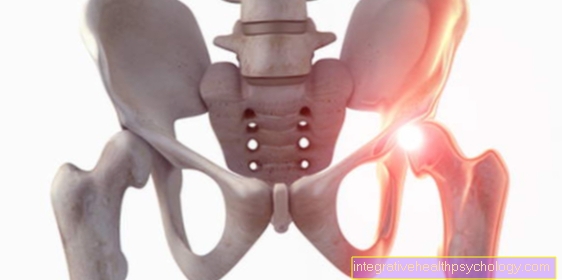Thyroxine
introduction
Thyroxine, or "T4", is a hormone produced in the thyroid gland. Thyroid hormones have a very broad spectrum of activity and are particularly important for energy metabolism, growth and maturation. Since thyroid hormones, and thus thyroxine, are subject to a superordinate and very complex control loop and are dependent on the presence of "iodine", the thyroid is very susceptible to functional disorders. Over- and under-functioning of the thyroid are therefore a very common clinical picture.
Read more on the subject: Thyroid hormones

Structure of thyroxine
Thyroxine is made and released in the thyroid gland. It consists, among other things, of two "molecular rings" which are connected to one another via an oxygen atom. There are a total of four iodine atoms on the two rings, two on the inner and two on the outer ring. For this reason, thyroxine is also known as "T4" or "tetraiodothyronine". The iodine thus represents an important building block in the synthesis of thyroid hormones. It is absorbed from the blood into the thyroid gland and immediately converted so that it cannot leave it again. This mechanism is also known as the “iodine trap”.
Since iodine is so essential for the synthesis of thyroid hormones and thus for their function, there should always be a sufficient supply of iodine in the body, otherwise there is a risk of hypothyroidism. This was a common problem, especially in earlier times, as there was no iodized salt yet. Today iodine deficiency is a rather rare cause of hypothyroidism in Europe.
The exact structure of thyroxine is very important for its function, as even a small difference can cause a large change in effect. The second important thyroid hormone "T3" or "triiodothyronine" serves as a good example. It differs from T4 only in that it has one less iodine on the outer ring and therefore only three iodine atoms in total.
Thyroid hormones are fat-soluble molecules. This means that they only dissolve in fatty substance and "precipitate" in water. It's like when someone drops a drop of fat in water and hopes that it will dissolve. Since thyroxine, like all hormones, is transported with the blood in the body and the blood is very watery, it has to be bound to a transport protein. When bound to the protein, thyroxine survives in the body for about a week. When the hormone has reached its destination, it separates from the transport protein and crosses the cell membrane of the target cell, where it unfolds its effect.
Tasks / function of thyroxine
Hormones are the so-called "messenger substances of the body". They are transported in the blood and pass on their information to the cells at their destination in a wide variety of ways. Thyroid hormones even transmit their signals directly to the DNA. They bind directly to these and promote the reading of the corresponding information, which is crucial for their effect. The disadvantage is that it takes significantly longer to implement an effect via the DNA. The advantage, however, is that both the lifespan of the hormones and the effects are more long-term.
The two thyroid hormones, thyroxine and triiodothyronine, only differ in their potency and can be converted into one another. Therefore, in the following, when thyroxine is mentioned, triiodothyronine is also meant.
The main tasks of the thyroid are energy metabolism and growth. Thyroxine promotes energy metabolism by increasing the amount of free sugar in the blood, which acts as an energy supplier. For this, on the one hand, the body's own production of sugar molecules is increased and, on the other hand, the existing sugar stores are broken down and released into the blood. In addition to the supply of sugar, another important supplier is made available, namely fats. Thyroxine promotes the breakdown of storage fat, which is also converted into energy in a more complex process. Another important effect is the lowering of the plasma cholesterol level by stimulating the cholesterol metabolism of the cells. The conversion of sugar and fat into energy also creates heat. This is additionally intensified by another, more complicated effect of thyroxine, which is why, for example, patients with an overactive thyroid often sweat and only wear light clothing on colder days.
In addition to the energy metabolism, the second major effect of thyroid hormones can be seen in growth. This plays an important role especially in children and adolescents and is therefore examined as part of the newborn screening. Thyroxine promotes the growth and maturation of cells, especially through the release of further growth hormones, and is especially important for the development of the brain in newborns. If an underactive thyroid is not discovered and treated in good time, it can lead to growth and development disorders.
In addition to the two main functions, thyroxine also acts on the connective tissue and has a promoting function there. A so-called "myxedema" can develop in patients with hypofunction. Thyroxine also affects the heart. There it causes both an increase in the heart rate and an increase in the force of contraction. As already mentioned, the thyroid gland produces a small amount of triiodothyronine (T3) in addition to thyroxine (T4). The two hormones work in the same way, but differ in their potency. T3 has an effect about three times as strong as T4. That is why a large proportion of the T4 (approx. 30%) is converted into T3 afterwards. However, triiodothyronine is not very stable and only survives in the blood for about a day.
Read more on the subject: T3 - T4 hormones
Thyroxine Synthesis
The synthesis of thyroxine takes place in the thyroid gland. This absorbs iodine from the blood and transfers it to the so-called "thyroglobulin". Thyreroglobulin is a chain-like protein found in the thyroid gland, which is the basis for the synthesis of thyroid hormones. The transfer of iodine creates molecules with either three or four iodine atoms. In the last step, parts of the protein chain are separated and, depending on the number of iodine atoms, the final hormones T3 (triiodothyronine) and T4 (tetraiodothyronine / thyroxine) are created.
Regulation mechanism
As messenger substances in the body, hormones are responsible for regulating various processes. In order to control their effect, however, they themselves are subjected to a very complex and sensitive regulatory mechanism. The origin is in a central region of the brain, the "hypothalamus". The hormone "TRH" (Thyrotropin Releasing Hormone) produced. TRH is released into the blood and travels to the next station in the control loop, the pituitary gland, or “pituitary gland”. There it causes the release of another hormone, the "TSH" (Thyroid stimulating hormone), which is now given back to the blood and reaches its final destination, the thyroid.
TSH signals the thyroid gland to release thyroxine (T4) and triiodothyronine (T3), which are distributed with the blood in the body and can now have their actual effect. The regulation mechanism is not only possible in one direction, but also in the other direction. T3 and T4 have an inhibitory effect on both TRH and TSH. This mechanism is known in medicine as "feedback inhibition". The thyroid hormones thus give feedback on how many hormones have already been released and thus prevent overproduction.
Read more on the subject: L-thyroxine
Hormone class
Thyroid hormones such as thyroxine (T4) and triiodothyronine (T3) belong to the so-called "lipophilic" hormones, which means that they are fat-soluble. They differ from the water-soluble (hydrophilic) hormones in that they are poorly soluble in the blood and therefore have to be bound to so-called transport proteins. Their advantage, however, is that, on the one hand, they have a longer lifespan and, on the other hand, they can very easily cross the cell membrane, which is also lipophilic, and transmit their signals directly to the DNA in the cell nucleus.





























